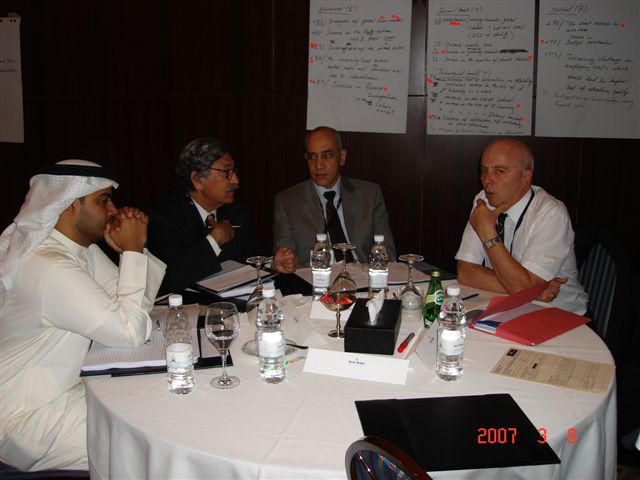|
Trends Defining the Context of Middle Eastern Higher Education

Trends are estimations/measurements of social, technological, economic, environmental, and political characteristics over time. They are gradual and long-term. Trend information may be used to describe the future, identify emerging issues, and project future events. Trend statements should be clearly stated, concise, and contain only one idea. In order to be useful in strategic planning and foresight, they need to be stated in operational terms in order to guide data collection (see, for example, the requests in brackets].
Each group was asked to identify as many trends as they could within the workshop time constraints and then select the five most critical trends. Below are the five most critical trends nominated by each group.
Group 1
Critical Trends
1.
Increase in demand for higher education.
2. Increase in number of female teachers.
[Need names of group members and the rest of the trends.]
Group 2
- Said Hamad Alrabiay, Oman
- M. Qasim Jan, Pakistan
- Hamad Al Alawi, Oman
- Faridah Ali, Kuwait
- Mukhtar Ahmed, Pakistan
Critical Trends
- Internationalization of standards
[In order to collect data on this trend, we need to specify its indicators.]
[Group comment: People desire good/quality education for their children. Market forces and employers want quality. Good quality brings prestige to institutions and its graduates.]
- Increase in number of private institutions
[Group comment: More and more private institutions are coming up in private sector. This trend is common throughout the region.]
- Increase in student enrollments
[Group comment: There is a global realization that the higher the educational qualification of a person the better his job performance. A corollary would be that higher qualification provides opportunities for jobs.]
- Increase in female students
[Group comment: In most countries of Middle East, women education is no more frowned on. As financial demands of families increase with industrialization, there is a growing toleration towards women participating in the work force.]
- Increased enrollment in service industry educational programs
[Group Comment: Rapid expansion and diversification of economy, industry and trade would require that people get job related application training in the respective fields.]
Group 3
Dr. Adbul-Rahim Sabouni UAE
Dr. Yousef Adbul Ghaffar, Bahraine
Dr. Majid Aldaihani, Kuwait
Mr. Ibrarim Jamch, UAE
Critical Trends
- Increased demand for skilled personnel
- Increased competition between universities in the region
- Increased number of programs seeking accreditation
- Increased number of institutions using technology-based education
[Need more specific indicators of “technology-based” education in order to collect data on this trend]
- Increased use of instructional programs using project-based learning
Group 4
Esam Agamy
Moh’d AlHamadi
Satish Gopinathan
Michael Irving
Harald Jorch
Critical Trends
- Increased use of outcome-based education
- Number of institutions applying for international accreditation
- Finances and infrastructure to support research
[This is an important area of concern, but it is not specified by indicators, which are necessary if we are to collect data on this topic area.]
- Islamic/Cultural values in the context of globalized education
[Again, an important area of concern, but the statement needs specific indicators that define what is meant by the statement that can lead to data collection and analysis.]
- Need for better preparation for post-secondary education
Other trends/topics considered but not selected for the top five most critical were:
- English language skills
- Importation of western education models
- Non-academic revenues
- Quality infrastructure
- Offices of Institutional Research & Planning
- Cost effectiveness and market needs
- Information Technology
- New Technologies (e.g. nanostructures)
- International students
- Oil and gas revenue fluctuations
- Vocational training
- Male/female balance
Group 5
Dr. Abood Al-Sawafi
Dr. Saleh Al-Nassar
Dr. Fahd Mohanadi
Dr. Khalid Kamal Naji
Critical Trends
1. Increase in globalization as indicated by the increased number of accredited programs
and the increased demand to align curricula with international markets
2. Increase in technology utilization in education as indicated by the number of PCs allocated to faculty members, the number of PCs allocated to students, and the number of student Internet subscriptions
3. Emergence of global local market as indicated by the employment trends among local graduates
[Need to specify employment trends.]
4. Increase in the number of private schools, programs, and universities
5. Proportion of funds allocated to education
|

